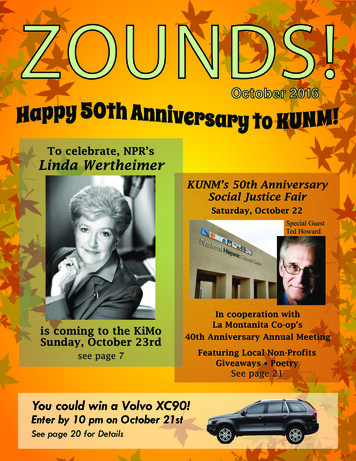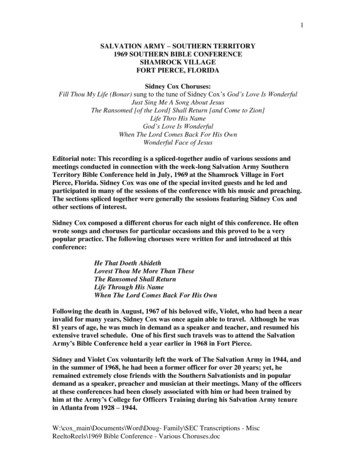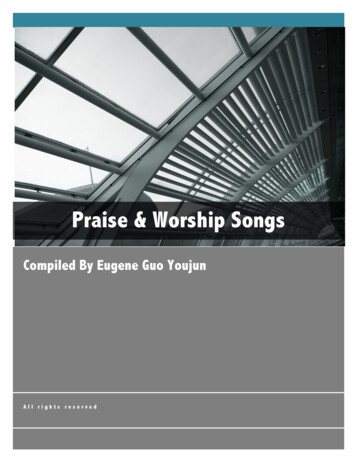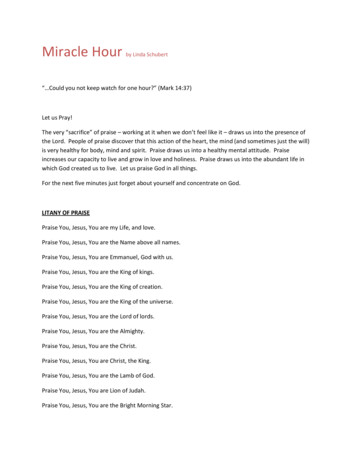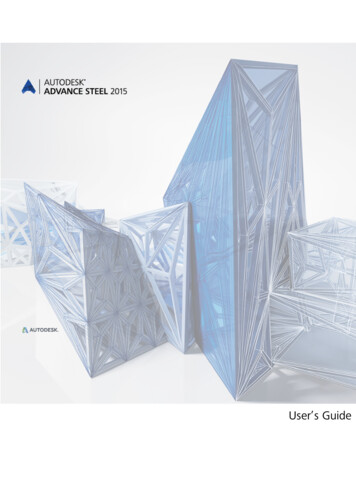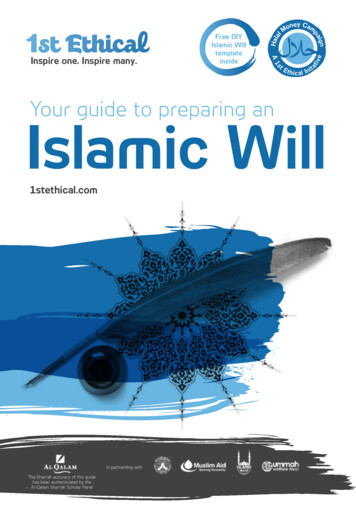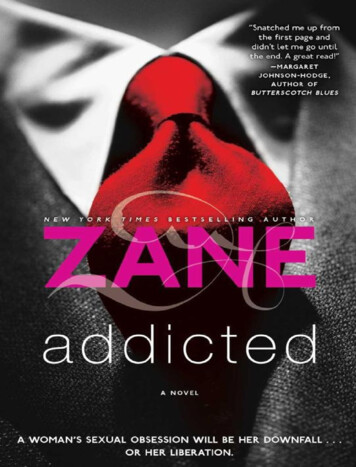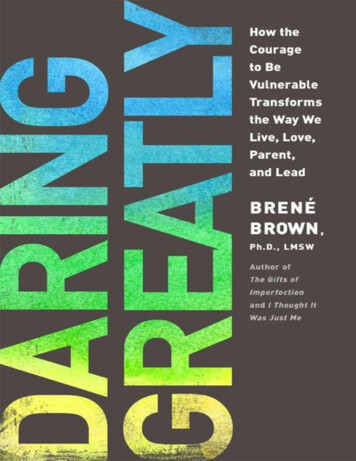
Transcription
Advance praise for Daring Greatly“A wonderful book: urgent, essential, and fun to read. I couldn’t put it down, and it continues toresonate with me.”—Seth Godin, New York Times bestselling author of Linchpin“The brilliantly insightful Brené Brown draws upon extensive research and personal experience toexplore the paradoxes of courage: We become strong by embracing vulnerability, we dare moregreatly when we acknowledge our fear. I can’t stop thinking about this book.”—Gretchen Rubin, New York Times bestselling author ofThe Happiness Project and Happiness at Home“In Daring Greatly, Brené Brown refers to herself as both a mapmaker and a traveler. In my book,that makes her a guide. And I believe the world needs more guides like her who are showing us awiser way to our inner world. If you’d like to set your course on being more courageous andconnected, engaged and resilient, leave the GPS at home. Daring Greatly is all the navigation you’llneed.”—Maria Shriver, New York Times bestselling author ofJust Who Will You Be?“Daring Greatly is an important book—a timely warning about the danger of pursuing certainty andcontrol above all. Brené Brown offers all of us a valuable guide to the real reward of vulnerability:greater courage.”—Daniel H. Pink, New York Times bestselling author ofDrive and A Whole New Mind“What I find remarkable about this book is the unique combination of solid research and kitchen-tablestorytelling. Brené becomes such a real person in the book that you can actually hear her voiceasking, ‘Have you dared greatly today?’ The invitation in this book is clear: We must be larger thananxiety, fear, and shame if we want to speak, act, and show up. The world needs this book and Brené’sunique blend of warmth, humor, and butt-kicking makes her the perfect person to inspire us to daregreatly.”—Harriet Lerner, Ph.D., New York Times bestselling author of The Dance of Anger and MarriageRules:A Manual for the Married and the Coupled Up“One of the tragic ironies of modern life is that so many people feel isolated from each other by thevery feelings they have in common: including a fear of failure and a sense of not being enough.Brené Brown shines a bright light into these dark recesses of human emotion and reveals how thesefeelings can gnaw at fulfillment in education, at work, and in the home. She shows too how they canbe transformed to help us live more wholehearted lives of courage, engagement, and purpose. BrenéBrown writes as she speaks, with wisdom, wit, candor, and a deep sense of humanity. If you’re astudent, teacher, parent, employer, employee, or just alive and wanting to live more fully, you shouldread this book. I double dare you.”—Sir Ken Robinson, New York Times bestselling author ofOut of Our Minds and The Element:
How Finding Your Passion Changes Everything“Here’s the essence of this book: Vulnerability is courage in you but inadequacy in me. Brené’s book,weaving together research and Texan anecdote, shows you the path forward. And don’t for a momentthink this is only for women. Men carry the burden of being strong and never weak, and we pay aheavy price for it. Daring Greatly can help us all.”—Michael Bungay Stanier, author of Do More Great Work“I deeply trust Brené Brown—her research, her intelligence, her integrity, and her personhood. Sowhen she definitively lands on the one most important value we can cultivate for professional success,relationship health, parental joy, and courageous, passionate living well, I sit up and take notice.And even when that one most critical value turns out to be the risky act of being vulnerable. Brenédared greatly to write this book, and you will benefit greatly to read it and to put its razor-sharpwisdom into action in your own life and work.”—Elizabeth Lesser, New York Times bestselling author ofBroken Open: How Difficult Times Can Help Us Growand cofounder of the Omega Institute“In an age of constant pressure to conform and pretend, Daring Greatly offers a compellingalternative: Transform your life by being who you really are. Embrace the courage to be vulnerable.Dare to read this book!”—Chris Guillebeau, New York Times bestselling author of The 100 Startup
DARING GREATLY
DARING GREATLYHow the Courage to Be Vulnerable Transforms the Way We Live, Love,Parent, and LeadBRENÉ BROWN,Ph.D., LMSWGOTHAMBOOKS
GOTHAM BOOKSPublished by Penguin Group (USA) Inc.375 Hudson Street, New York, New York 10014, U.S.A.Penguin Group (Canada), 90 Eglinton Avenue East, Suite 700, Toronto, Ontario M4P 2Y3, Canada (a division of Pearson Penguin Canada Inc.); Penguin Books Ltd, 80Strand, London WC2R 0RL, England; Penguin Ireland, 25 St Stephen’s Green, Dublin 2, Ireland (a division of Penguin Books Ltd); Penguin Group (Australia), 250Camberwell Road, Camberwell, Victoria 3124, Australia (a division of Pearson Australia Group Pty Ltd); Penguin Books India Pvt Ltd, 11 Community Centre, PanchsheelPark, New Delhi–110 017, India; Penguin Group (NZ), 67 Apollo Drive, Rosedale, Auckland 0632, New Zealand (a division of Pearson New Zealand Ltd); Penguin Books(South Africa) (Pty) Ltd, 24 Sturdee Avenue, Rosebank, Johannesburg 2196, South AfricaPenguin Books Ltd, Registered Offices: 80 Strand, London WC2R 0RL, EnglandPublished by Gotham Books, a member of Penguin Group (USA) Inc.First printing, September 201210 9 8 7 6 5 4 3 2 1Copyright 2012 by Brené BrownAll rights reserved. No part of this book may be reproduced, scanned, or distributed in any printed or electronic form without permission. Please do not participate in orencourage piracy of copyrighted materials in violation of the author’s rights. Purchase only authorized editions.Gotham Books and the skyscraper logo are trademarks of Penguin Group (USA) Inc.LIBRARY OF CONGRESS CATALOGING-IN-PUBLICATION DATABrown, C. Brené.Daring greatly : how the courage to be vulnerable transforms the way we live, love, parent, and lead / Brené Brown.—1st ed.p. cm.Includes bibliographical references.ISBN: 978-1-101-59499-51. Assertiveness (Psychology) 2. Risk. 3. Courage. I. Title.BF575.A85B76 2012158—dc232012018649Printed in the United States of AmericaSet in Janson TextDesigned by Spring HotelingWhile the author has made every effort to provide accurate telephone numbers, Internet addresses, and other contact information at the time of publication, neither thepublisher nor the author assumes any responsibility for errors, or for changes that occur after publication. Further, the publisher does not have any control over and does notassume any responsibility for author or third-party websites or their content.Except for friends and family, names and identifying characteristics of individuals mentioned have been changed to protect their privacy.ALWAYS LEARNINGPEARSON
To SteveYou make the world a better placeand me a braver person.
CONTENTSWhat It Meansto Dare GreatlyIntroduction:My Adventures in the ArenaCHAPTER 1Scarcity: Looking InsideOur Culture of “Never Enough”CHAPTER 2Debunking theVulnerability MythsCHAPTER 3Understanding andCombating ShameCHAPTER 4The Vulnerability ArmoryCHAPTER 5Mind the Gap: Cultivating Change andClosing the Disengagement DivideCHAPTER 6Disruptive Engagement:Daring to Rehumanize Education and WorkCHAPTER 7Wholehearted Parenting:Daring to Be the AdultsWe Want Our Children to BeFinal ThoughtsAppendix—Trust in Emergence:
Grounded Theory and My Research ProcessPracticing GratitudeNotes and ReferencesIndexAbout the Author
WHAT ITMEANS TODAREGREATLY
THE phrase Daring Greatly is from Theodore Roosevelt’s speech “Citizenship in a Republic.”The speech, sometimes referred to as “The Man in the Arena,” was delivered at the Sorbonne in Paris,France, on April 23, 1910. This is the passage that made the speech famous:“It is not the critic who counts; not the man who points out how the strong man stumbles, or where the doer of deeds could have done them better.The credit belongs to the man who is actually in the arena, whose face is marred by dust and sweat and blood; who strives valiantly; who errs, who comes shortagain and again,because there is no effort without error and shortcoming; but who does actually strive to do the deeds; who knows great enthusiasms, the great devotions; whospends himself in a worthy cause;who at the best knows in the end the triumph of high achievement, and who at the worst, if he fails, at least fails while daring greatly. ”The first time I read this quote, I thought, This is vulnerability. Everything I’ve learned from over adecade of research on vulnerability has taught me this exact lesson. Vulnerability is not knowingvictory or defeat, it’s understanding the necessity of both; it’s engaging. It’s being all in.Vulnerability is not weakness, and the uncertainty, risk, and emotional exposure we face every dayare not optional. Our only choice is a question of engagement. Our willingness to own and engagewith our vulnerability determines the depth of our courage and the clarity of our purpose; the level towhich we protect ourselves from being vulnerable is a measure of our fear and disconnection.When we spend our lives waiting until we’re perfect or bulletproof before we walk into the arena,we ultimately sacrifice relationships and opportunities that may not be recoverable, we squander ourprecious time, and we turn our backs on our gifts, those unique contributions that only we can make.Perfect and bulletproof are seductive, but they don’t exist in the human experience. We must walkinto the arena, whatever it may be—a new relationship, an important meeting, our creative process, ora difficult family conversation—with courage and the willingness to engage. Rather than sitting onthe sidelines and hurling judgment and advice, we must dare to show up and let ourselves be seen.This is vulnerability. This is daring greatly.Join me as we explore the answers to these questions:What drives our fear of being vulnerable?How are we protecting ourselves from vulnerability?What price are we paying when we shut down and disengage?How do we own and engage with vulnerability so we can start transforming the way we live,love, parent, and lead?
INTRODUCTION:MY ADVENTURESIN THE ARENA
I looked right at her and said, “I frickin’ hate vulnerability.” I figured she’s a therapist—I’m sureshe’s had tougher cases. Plus, the sooner she knows what she’s dealing with, the faster we can get thiswhole therapy thing wrapped up. “I hate uncertainty. I hate not knowing. I can’t stand opening myselfto getting hurt or being disappointed. It’s excruciating. Vulnerability is complicated. And it’sexcruciating. Do you know what I mean?”Diana nods. “Yes, I know vulnerability. I know it well. It’s an exquisite emotion.” Then she looks upand kind of smiles, as if she’s picturing something really beautiful. I’m sure I look confused because Ican’t imagine what she’s picturing. I’m suddenly concerned for her well-being and my own.“I said it was excruciating, not exquisite,” I point out. “And let me say this for the record, if myresearch didn’t link being vulnerable with living a Wholehearted life, I wouldn’t be here. I hate how itmakes me feel.”“What does it feel like?”“Like I’m coming out of my skin. Like I need to fix whatever ’s happening and make it better.”“And if you can’t?”“Then I feel like punching someone in the face.”“And do you?”“No. Of course not.”“So what do you do?”“Clean the house. Eat peanut butter. Blame people. Make everything around me perfect. Controlwhatever I can—whatever ’s not nailed down.”“When do you feel the most vulnerable?”“When I’m in fear.” I look up as Diana responds with that annoying pause and head-nodding doneby therapists to draw us out. “When I’m anxious and unsure about how things are going to go, or ifI’m having a difficult conversation, or if I’m trying something new or doing something that makesme uncomfortable or opens me up to criticism or judgment.” Another annoying pause as the empathicnodding continues. “When I think about how much I love my kids and Steve, and how my life wouldbe over if something happened to them. When I see the people I care about struggling, and I can’t fixit or make it better. All I can do is be with them.”“I see.”“I feel it when I’m scared that things are too good. Or too scary. I’d really like for it to be exquisite,but right now it’s just excruciating. Can people change that?”“Yes, I believe they can.”“Can you give me some homework or something? Should I review the data?”“No data and no homework. No assignments or gold stars in here. Less thinking. More feeling.”“Can I get to exquisite without having to feel really vulnerable in the process?”“No.”“Well, shit. That’s just awesome.”If you don’t know anything about me from my other books, my blog, or the TED videos that havegone viral online, let me catch you up. If, on the other hand, you’re already a little queasy from themention of a therapist, skip this chapter entirely and go straight to the appendix about my researchprocess. I have spent my entire life trying to outrun and outsmart vulnerability. I’m a fifth-generationTexan with a family motto of “lock and load,” so I come by my aversion to uncertainty and emotionalexposure honestly (and genetically). By middle school, which is the time when most of us begin towrestle with vulnerability, I began to develop and hone my vulnerability-avoidance skills.Over time I tried everything from “the good girl” with my “perform-perfect-please” routine, to
clove-smoking poet, angry activist, corporate climber, and out-of-control party girl. At first glancethese may seem like reasonable, if not predictable, developmental stages, but they were more than thatfor me. All of my stages were different suits of armor that kept me from becoming too engaged andtoo vulnerable. Each strategy was built on the same premise: Keep everyone at a safe distance andalways have an exit strategy.Along with my fear of vulnerability, I also inherited a huge heart and ready empathy. So, in my latetwenties, I left a management position at AT&T, got a job waiting tables and bartending, and wentback to school to become a social worker. When I met with my boss at AT&T to resign, I’ll neverforget her response: “Let me guess. You’re leaving to become a social worker or an MTV VJ onHeadbanger’s Ball?”Like many of the folks drawn to social work, I liked the idea of fixing people and systems. By thetime I was done with my bachelor ’s degree (BSW) and was finishing my master ’s degree (MSW),though, I had realized that social work wasn’t about fixing. It was and is all about contextualizing and“leaning in.” Social work is all about leaning into the discomfort of ambiguity and uncertainty, andholding open an empathic space so people can find their own way. In a word—messy.As I struggled to figure out how I could ever make a career in social work actually work, I wasriveted by a statement from one of my research professors: “If you can’t measure it, it doesn’t exist.”He explained that unlike our other classes in the program, research was all about prediction andcontrol. I was smitten. You mean that rather than leaning and holding, I could spend my careerpredicting and controlling? I had found my calling.The surest thing I took away from my BSW, MSW, and Ph.D. in social work is this: Connection iswhy we’re here. We are hardwired to connect with others, it’s what gives purpose and meaning to ourlives, and without it there is suffering. I wanted to develop research that explained the anatomy ofconnection.Studying connection was a simple idea, but before I knew it, I had been hijacked by my researchparticipants who, when asked to talk about their most important relationships and experiences ofconnection, kept telling me about heartbreak, betrayal, and shame—the fear of not being worthy ofreal connection. We humans have a tendency to define things by what they are not. This is especiallytrue of our emotional experiences.By accident, then, I became a shame and empathy researcher, spending six years developing atheory that explains what shame is, how it works, and how we cultivate resilience in the face ofbelieving that we’re not enough—that we’re not worthy of love and belonging. In 2006 I realized thatin addition to understanding shame, I had to understand the flip side: “What do the people who are themost resilient to shame, who believe in their worthiness—I call these people the Wholehearted—havein common?”I hoped like hell that the answer to this question would be: “They are shame researchers. To beWholehearted, you have to know a lot about shame.” But I was wrong. Understanding shame is onlyone variable that contributes to Wholeheartedness, a way of engaging with the world from a place ofworthiness. In The Gifts of Imperfection, I defined ten “guideposts” for Wholehearted living that pointto what the Wholehearted work to cultivate and what they work to let go ivatingCultivatingAuthenticity: Letting Go of What People ThinkSelf-Compassion: Letting Go of Perfectionisma Resilient Spirit: Letting Go of Numbing and PowerlessnessGratitude and Joy: Letting Go of Scarcity and Fear of the DarkIntuition and Trusting Faith: Letting Go of the Need for Certainty
6. Cultivating Creativity: Letting Go of Comparison7. Cultivating Play and Rest: Letting Go of Exhaustion as a Status Symbol and Productivity as SelfWorth8. Cultivating Calm and Stillness: Letting Go of Anxiety as a Lifestyle9. Cultivating Meaningful Work: Letting Go of Self-Doubt and “Supposed To”10. Cultivating Laughter, Song, and Dance: Letting Go of Being Cool and “Always in Control”As I analyzed the data, I realized that I was about two for ten in my own life when in comes toWholehearted living. That was personally devastating. This happened a few weeks before my fortyfirst birthday and sparked my midlife unraveling. As it turns out, getting an intellectual handle onthese issues isn’t the same as living and loving with your whole heart.I have written in great detail in The Gifts of Imperfection about what it means to be Wholeheartedand about the breakdown spiritual awakening that ensued from this realization. But what I want to dohere is to share the definition of Wholehearted living and share the five most important themes thatemerged from the data and which led me to the breakthroughs I share in this book. It will give you anidea of what’s ahead:Wholehearted living is about engaging in our lives from a place of worthiness. It means cultivatingthe courage, compassion, and connection to wake up in the morning and think, No matter what getsdone and how much is left undone, I am enough. It’s going to bed at night thinking, Yes, I am imperfectand vulnerable and sometimes afraid, but that doesn’t change the truth that I am also brave andworthy of love and belonging.This definition is based on these fundamental ideals:1. Love and belonging are irreducible needs of all men, women, and children. We’re hardwired forconnection—it’s what gives purpose and meaning to our lives. The absence of love, belonging,and connection always leads to suffering.2. If you roughly divide the men and women I’ve interviewed into two groups—those who feel adeep sense of love and belonging, and those who struggle for it—there’s only one variable thatseparates the groups: Those who feel lovable, who love, and who experience belonging simplybelieve they are worthy of love and belonging. They don’t have better or easier lives, they don’thave fewer struggles with addiction or depression, and they haven’t survived fewer traumas orbankruptcies or divorces, but in the midst of all of these struggles, they have developed practicesthat enable them to hold on to the belief that they are worthy of love, belonging, and even joy.3. A strong belief in our worthiness doesn’t just happen—it’s cultivated when we understand theguideposts as choices and daily practices.4. The main concern of Wholehearted men and women is living a life defined by courage,compassion, and connection.5. The Wholehearted identify vulnerability as the catalyst for courage, compassion, and connection.In fact, the willingness to be vulnerable emerged as the single clearest value shared by all of thewomen and men whom I would describe as Wholehearted. They attribute everything—from theirprofessional success to their marriages to their proudest parenting moments—to their ability tobe vulnerable.I had written about vulnerability in my earlier books; in fact, there’s even a chapter on it in mydissertation. From the very beginning of my investigations, embracing vulnerability emerged as animportant category. I also understood the relationships between vulnerability and the other emotions
that I’ve studied. But in those previous books, I assumed that the relationships between vulnerabilityand different constructs like shame, belonging, and worthiness were coincidence. Only after twelveyears of dropping deeper and deeper into this work did I finally understand the role it plays in ourlives. Vulnerability is the core, the heart, the center, of meaningful human experiences.This new information created a major dilemma for me personally: On the one hand, how can youtalk about the importance of vulnerability in an honest and meaningful way without being vulnerable?On the other hand, how can you be vulnerable without sacrificing your legitimacy as a researcher?To be honest, I think emotional accessibility is a shame trigger for researchers and academics. Veryearly in our training, we are taught that a cool distance and inaccessibility contribute to prestige, andthat if you’re too relatable, your credentials come into question. While being called pedantic is aninsult in most settings, in the ivory tower we’re taught to wear the pedantic label like a suit of armor.How could I risk being really vulnerable and tell stories about my own messy journey through thisresearch without looking like a total flake? What about my professional armor?My moment to “dare greatly,” as Theodore Roosevelt once urged citizens to do, came in June 2010when I was invited to speak at TEDxHouston. TEDxHouston is one of many independently organizedevents modeled after TED—a nonprofit addressing the worlds of Technology, Entertainment, andDesign that is devoted to “Ideas Worth Spreading.” TED and TEDx organizers bring together “theworld’s most fascinating thinkers and doers” and challenge them to give the talk of their life ineighteen minutes or less.The TEDxHouston curators were unlike any event organizers I’ve known. Bringing in a shameand-vulnerability researcher makes most organizers a little nervous and compels a few to getsomewhat prescriptive about the content of the talk. When I asked the TEDx people what they wantedme to talk about, they responded, “We love your work. Talk about whatever makes you feel awesome—do your thing. We’re grateful to share the day with you.” Actually, I’m not sure how they made thedecision to let me do my thing, because before that talk I wasn’t aware of having a thing.I loved the freedom of that invitation and I hated it. I was back straddling the tension betweenleaning into the discomfort and finding refuge in my old friends, prediction and control. I decided togo for it. Truthfully, I had no idea what I was getting into.My decision to dare greatly didn’t stem from self-confidence as much as it did from faith in myresearch. I know I’m a good researcher, and I trusted that the conclusions I had drawn from the datawere valid and reliable. Vulnerability would take me where I wanted or maybe needed to go. I alsoconvinced myself that it wasn’t really a big deal: It’s Houston, a hometown crowd. Worst-casescenario, five hundred people plus a few watching the live streaming will think I’m a nut.The morning after the talk, I woke up with one of the worst vulnerability hangovers of my life. Youknow that feeling when you wake up and everything feels fine until the memory of laying yourselfopen washes over you and you want to hide under the covers? What did I do? Five hundred peopleofficially think I’m crazy and it totally sucks. I forgot to mention two important things. Did I actuallyhave a slide with the word breakdown on it to reinforce the story that I shouldn’t have told in the firstplace? I must leave town.But there was nowhere to run. Six months after the talk, I received an e-mail from the curators ofTEDxHouston congratulating me because my talk was going to be featured on the main TED website.I knew that was a good thing, a coveted honor even, but I was terrified. First, I was just settling intothe idea of “only” five hundred people thinking I’m crazy. Second, in a culture full of critics andcynics, I had always felt safer in my career flying right under the radar. Looking back, I’m not surehow I would have responded to that e-mail had I known that having a video go viral on vulnerabilityand the importance of letting ourselves be seen would leave me feeling so uncomfortably (andironically) vulnerable and exposed.
Today that talk is one of the most viewed on TED.com, with more than five million hits andtranslation available in thirty-eight languages. I’ve never watched it. I’m glad I did it, but it still makesme feel really uncomfortable.The way I see it, 2010 was the year of the TEDxHouston talk, and 2011 was the year of walking thetalk—literally. I crisscrossed the country speaking to groups ranging from Fortune 500 companies,leadership coaches, and the military, to lawyers, parenting groups, and school districts. In 2012, I wasinvited to give another talk at the main TED conference in Long Beach, California. For me the 2012talk was my opportunity to share the work that has literally been the foundation and springboard forall of my research—I talked about shame and how we have to understand it and work through it if wereally want to dare greatly.The experience of sharing my research led me to write this book. After discussions with mypublisher about the possibility of a business book and/or a parenting book, plus a book for teachers, Irealized that there only needed to be one book because no matter where I went or with whom I wasspeaking, the core issues were the same: fear, disengagement, and yearning for more courage.My corporate talks almost always focus on inspired leadership or creativity and innovation. Themost significant problems that everyone from C-level executives to the frontline folks talk to meabout stem from disengagement, the lack of feedback, the fear of staying relevant amid rapid change,and the need for clarity of purpose. If we want to reignite innovation and passion, we have torehumanize work. When shame becomes a management style, engagement dies. When failure is notan option we can forget about learning, creativity, and innovation.When it comes to parenting, the practice of framing mothers and fathers as good or bad is bothrampant and corrosive—it turns parenting into a shame minefield. The real questions for parentsshould be: “Are you engaged? Are you paying attention?” If so, plan to make lots of mistakes and baddecisions. Imperfect parenting moments turn into gifts as our children watch us try to figure out whatwent wrong and how we can do better next time. The mandate is not to be perfect and raise happychildren. Perfection doesn’t exist, and I’ve found that what makes children happy doesn’t alwaysprepare them to be courageous, engaged adults. The same is true for schools. I haven’t encountered asingle problem that isn’t attributed to some combination of parental, teacher, administrative, and/orstudent disengagement and the clash of competing stakeholders vying to define one purpose.I have found that the most difficult and most rewarding challenge of my work is how to be both amapmaker and a traveler. My maps, or theories, on shame resilience, Wholeheartedness, andvulnerability have not been drawn from the experiences of my own travels, but from the data I’vecollected over the past dozen years—the experiences of thousands of men and women who areforging paths in the direction that I, and many others, want to take our lives.Over the years I’ve learned that a surefooted and confident mapmaker does not a swift travelermake. I stumble and fall, and I constantly find myself needing to change course. And even though I’mtrying to follow a map that I’ve drawn, there are many times when frustration and self-doubt takeover, and I wad up that map and shove it into the junk drawer in my kitchen. It’s not an easy journeyfrom excruciating to exquisite, but for me it’s been worth every step.What we all share in common—what I’ve spent the past several years talking to leaders, parents,and educators about—is the truth that forms the very core of this book: What we know matters, butwho we are matters more. Being rather than knowing requires showing up and letting ourselves beseen. It requires us to dare greatly, to be vulnerable. The first step of that journey is understandingwhere we are, what we’re up against, and where we need to go. I think we can best do that byexamining our pervasive “Never Enough” culture.
CHAPTER 1SCARCITY:LOOKING INSIDE OUR CULTURE OF “NEVER ENOUGH”After doing this work for the past twelve years and watching scarcity ride roughshod over our families, organizations, and communities, I’d say the one thing wehave in common is that we’re sick of feeling afraid. We want to dare greatly. We’re tired of the national conversation centering on “What should we fear?” and“Who should we blame?” We all want to be brave.
YOU can’t swing a cat without hitting a narcissist.”Granted, it wasn’t my most eloquent moment onstage. It also wasn’t my intention to offend anyone,but when I’m really fired up or frustrated, I tend to revert back to the language instilled in me by thegenerations of Texans who came before me. I swing cats, things get stuck in my craw, and I’mfrequently “fixin’ to come undone.” These regressions normally h
Advance praise for Daring Greatly “A wonderful book: urgent, essential, and fun to read. I couldn’t put it down, and it continues to resonate with me.” —Seth Godin, New York Times bestselling author of Linchpin “The brilliantly insightful Brené Brown
